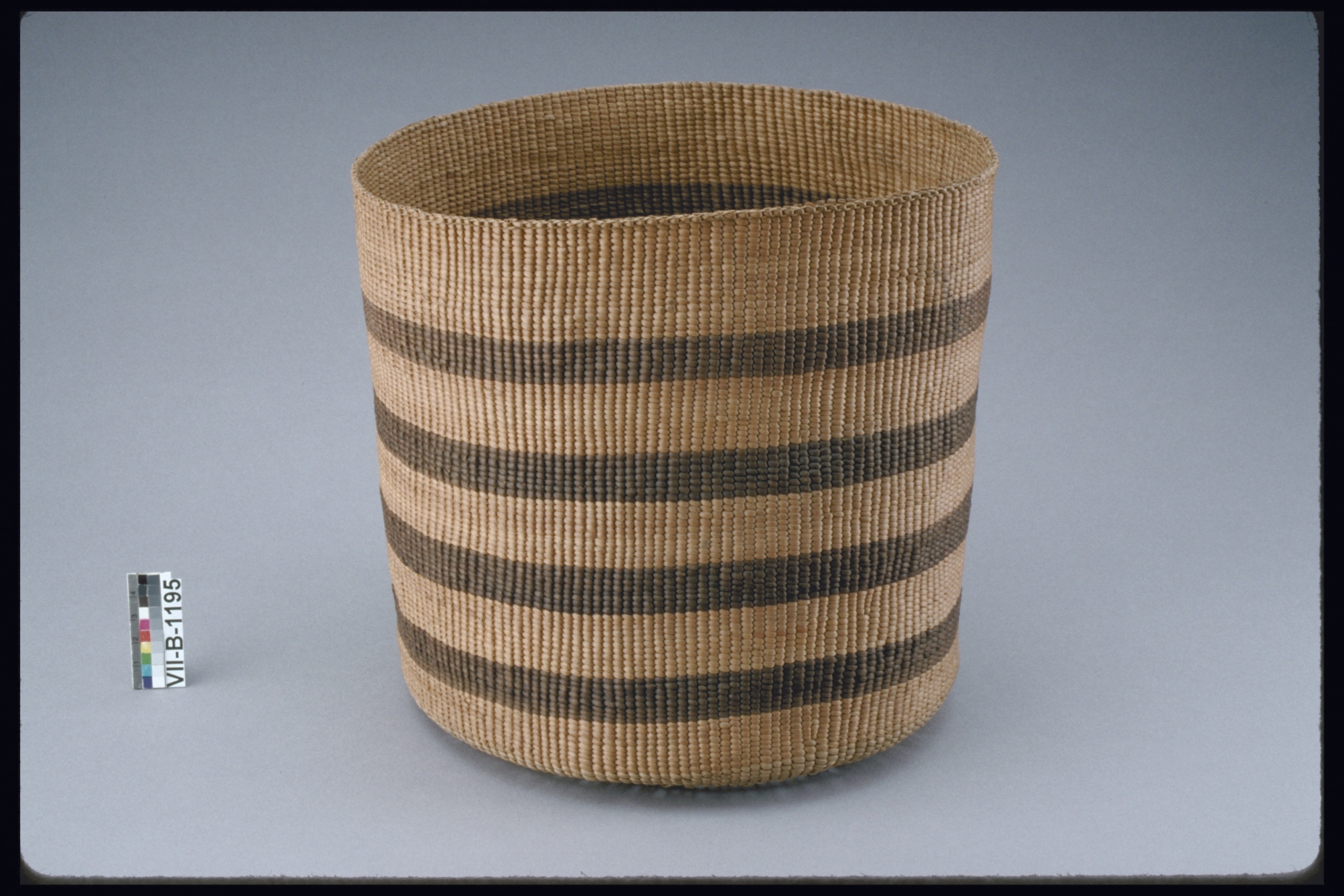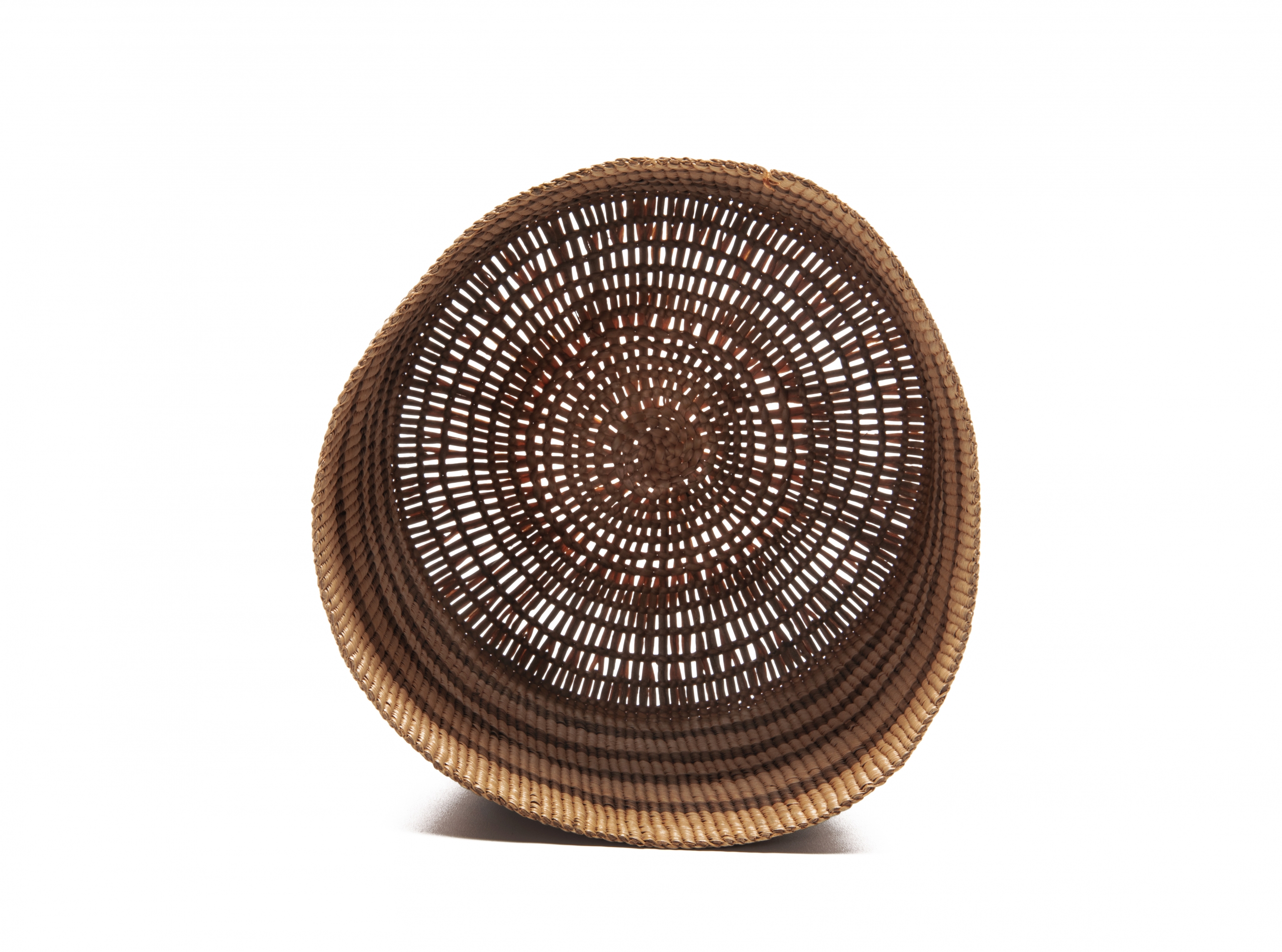Basket
Artifact
Image
Video
Audio
 Activities
Activities
THINK
How important do you think káadii (spruce-root baskets) like this were to X̱aaydaa (Haida) at the turn of the century? Imagine the perspective of the jáadee (woman) who wove the basket. How much time and effort went into hlíingdáang (gathering the spruce roots), preparing them and then ginn xaygang (weaving the basket)? If the basket was damaged, how easy would it be to repair or replace it? Explain your thinking to a partner.
THINK
What do you think this káadii (spruce-root basket) was used for? Was it used daily or offered as a trade item? Find evidence for your answer in the historical context provided.
LOOK
Notice the spaces woven into the pattern on the base of the káadii (spruce-root basket). Based on its size and this pattern, what do you think this basket was used for? Use the historical context provided to corroborate your ideas.
Details
 Materials
Materials - Spruce Roots
Historical Context
Choose one of the three levels below to match your needs.
- This káadii (basket) was made from dyed and non-dyed spruce roots.
- It has an open-weave bottom (like a sieve) so liquid can drain from it.
- This basket was made by a ginn xay ‘leeygaa (Haida weaver).
This káadii (basket) was woven from dyed and non-dyed spruce roots. Its black bands are a common decoration in woven Haida baskets. The bottom of the basket has an open weave (like a sieve), which allows liquid to drain from it. This basket was probably made for harvesting berries.
This basket was made by a ginn xay ‘leeygaa (Haida weaver). It was collected in 1919 in the vicinity of the town of G̱aw Tlagée (Masset), but may have been made earlier.
This káadii (basket) was woven from dyed and non-dyed spruce roots. Its black bands, made by dying spruce roots with the juice of berries, are a common decoration on káadii (spruce-root baskets). The bottom of the basket has an open weave (like a sieve), which allows liquid to drain from it. This basket was probably made for harvesting berries.
This káadii (spruce-root basket) was made by a ginn xay ‘leeygaa (Haida weaver) and was collected by Harlan I. Smith in the fall of 1919, in or around the town of G̱aw Tlagée (Masset).
- This káadii (basket) was made from dyed and non-dyed spruce roots.
- It has an open-weave bottom (like a sieve) so liquid can drain from it.
- This basket was made by a ginn xay ‘leeygaa (Haida weaver).
This káadii (basket) was woven from dyed and non-dyed spruce roots. Its black bands are a common decoration in woven Haida baskets. The bottom of the basket has an open weave (like a sieve), which allows liquid to drain from it. This basket was probably made for harvesting berries.
This basket was made by a ginn xay ‘leeygaa (Haida weaver). It was collected in 1919 in the vicinity of the town of G̱aw Tlagée (Masset), but may have been made earlier.
This káadii (basket) was woven from dyed and non-dyed spruce roots. Its black bands, made by dying spruce roots with the juice of berries, are a common decoration on káadii (spruce-root baskets). The bottom of the basket has an open weave (like a sieve), which allows liquid to drain from it. This basket was probably made for harvesting berries.
This káadii (spruce-root basket) was made by a ginn xay ‘leeygaa (Haida weaver) and was collected by Harlan I. Smith in the fall of 1919, in or around the town of G̱aw Tlagée (Masset).
Summary
- This káadii (basket) was made from dyed and non-dyed spruce roots.
- It has an open-weave bottom (like a sieve) so liquid can drain from it.
- This basket was made by a ginn xay ‘leeygaa (Haida weaver).
Essential
This káadii (basket) was woven from dyed and non-dyed spruce roots. Its black bands are a common decoration in woven Haida baskets. The bottom of the basket has an open weave (like a sieve), which allows liquid to drain from it. This basket was probably made for harvesting berries.
This basket was made by a ginn xay ‘leeygaa (Haida weaver). It was collected in 1919 in the vicinity of the town of G̱aw Tlagée (Masset), but may have been made earlier.
In-Depth
This káadii (basket) was woven from dyed and non-dyed spruce roots. Its black bands, made by dying spruce roots with the juice of berries, are a common decoration on káadii (spruce-root baskets). The bottom of the basket has an open weave (like a sieve), which allows liquid to drain from it. This basket was probably made for harvesting berries.
This káadii (spruce-root basket) was made by a ginn xay ‘leeygaa (Haida weaver) and was collected by Harlan I. Smith in the fall of 1919, in or around the town of G̱aw Tlagée (Masset).


